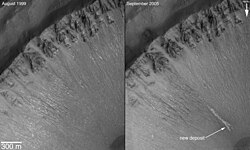NASA: Signs of liquid water found on surface of Mars
Thursday, December 7, 2006

NASA scientists have announced that the Mars Global Surveyor has captured images of deposits in gullies on the surface of the planet Mars which have been created since the areas were photographed seven years ago. These deposits are believed to be the residue of liquid water breaking out of cliffs and crater walls, carrying sediment downhill through the gullies, and later evaporating. The gullies are located inside the Terra Sirenum crater and the Centauri Montes regions.
"These observations give the strongest evidence to date that water still flows occasionally on the surface of Mars," said the head scientist for the Mars Exploration Program in Washington D.C., Michael Meyer.
The bright appearance of the deposits suggests that, at some recent period, the surface material in these gullies has either been heavily disturbed or covered over by new, different, material. Whilst it is not proven that this is the result of water activity—it could be frost, for example, or the result of localized landslides—it ties in with previous theories that suggest liquid water is locked below the surface of Mars, occasionally being released in short and violent local bursts.
"These fresh deposits suggest that at some places and times on present-day Mars, liquid water is emerging from beneath the ground and briefly flowing down the slopes. This possibility raises questions about how the water would stay melted below ground, how widespread it might be, and whether there's a below-ground wet habitat conducive to life." said Michael Malin of Malin Space Science Systems located in San Diego, California. Malin is the head investigator for the Mars Orbital Camera, the instrument which made these photographs, and is the author of the report about the discovery, published in the journal Science.

One factor suggesting water is the shape of the deposits, which are sinuous and appear to "flow" downhill. "The shapes of these deposits are what you would expect to see if the material were carried by flowing water. They have finger-like branches at the downhill end and easily diverted around small obstacles," explained Malin. Scientists do not know how or why the water is making its way to the surface. "The big question is how does it happen, and does it point to a habitat for life?" said Meyer.
However, many in the scientific community stress possible alternative explanations for what has been seen, suggesting that the features could have been created by dust, sand or liquid carbon dioxide. Oded Aharonson of the California Institute of Technology (Caltech) described the hypothesis of recent water activity on Mars as just one possible explanation and insisted further study was needed to determine whether the deposits could have been left there by the flow of dust rather than water.
Other scientists think it possible that the gullies were caused by liquid carbon dioxide. One reason is that computer models of the Martian crust indicate water could exist only at depths of several kilometers, but liquid carbon dioxide could persist much nearer the surface.
Contact was lost with Mars Global Surveyor in November, and has not yet been recovered. The spacecraft has been in orbit since 1997, operating over a lifespan which far exceeded the two-year mission originally planned. NASA's Jet Propulsion Laboratory, Pasadena, manages the Mars Global Surveyor mission for the NASA Science Mission Directorate located in Washington D.C..
Sources
- Rick Weiss. "Mars Photos May Indicate The Recent Flow of Water" — Washington Post, December 7, 2006
- "NASA Images Suggest Water Still Flows in Brief Spurts on Mars" — NASA, December 6, 2006
- "Water 'flowed recently' on Mars" — BBC, December 6, 2006

